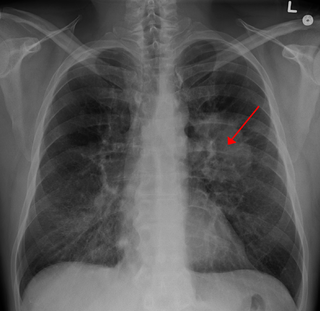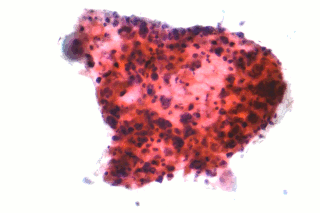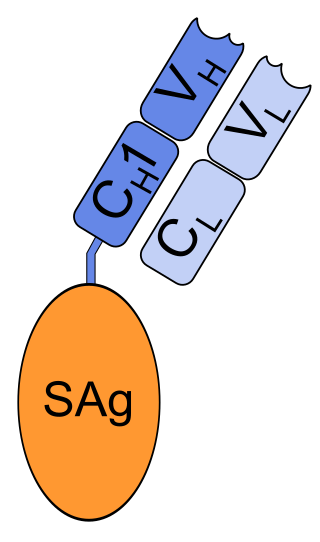
Lung cancer, also known as lung carcinoma, is a malignant tumor that begins in the lung. Lung cancers are caused by genetic damage to the DNA of cells in the airways, often exacerbated by cigarette smoking, or inhaling damaging chemicals. Damaged airway cells sometimes gain the ability to proliferate unchecked, causing the growth of a tumor. Without treatment, lung tumors can spread throughout the lung, damaging lung function. Eventually lung tumors metastasize, spreading to distant parts of the body, and causing varying disease. Lung cancers are classified based on the cells they originate from. Around 15% are small-cell lung cancers, while the remaining 85% are adenocarcinomas, squamous-cell carcinomas, and large-cell carcinomas.

A biopsy is a medical test commonly performed by a surgeon, interventional radiologist, or an interventional cardiologist. The process involves extraction of sample cells or tissues for examination to determine the presence or extent of a disease. The tissue is then fixed, dehydrated, embedded, sectioned, stained and mounted before it is generally examined under a microscope by a pathologist; it may also be analyzed chemically. When an entire lump or suspicious area is removed, the procedure is called an excisional biopsy. An incisional biopsy or core biopsy samples a portion of the abnormal tissue without attempting to remove the entire lesion or tumor. When a sample of tissue or fluid is removed with a needle in such a way that cells are removed without preserving the histological architecture of the tissue cells, the procedure is called a needle aspiration biopsy. Biopsies are most commonly performed for insight into possible cancerous or inflammatory conditions.

Small-cell carcinoma is a type of highly malignant cancer that most commonly arises within the lung, although it can occasionally arise in other body sites, such as the cervix, prostate, and gastrointestinal tract. Compared to non-small cell carcinoma, small cell carcinoma has a shorter doubling time, higher growth fraction, and earlier development of metastases.

Targeted therapy or molecularly targeted therapy is one of the major modalities of medical treatment (pharmacotherapy) for cancer, others being hormonal therapy and cytotoxic chemotherapy. As a form of molecular medicine, targeted therapy blocks the growth of cancer cells by interfering with specific targeted molecules needed for carcinogenesis and tumor growth, rather than by simply interfering with all rapidly dividing cells. Because most agents for targeted therapy are biopharmaceuticals, the term biologic therapy is sometimes synonymous with targeted therapy when used in the context of cancer therapy. However, the modalities can be combined; antibody-drug conjugates combine biologic and cytotoxic mechanisms into one targeted therapy.

Non-small-cell lung cancer (NSCLC), or non-small-cell lung carcinoma, is any type of epithelial lung cancer other than small-cell lung cancer (SCLC). NSCLC accounts for about 85% of all lung cancers. As a class, NSCLCs are relatively insensitive to chemotherapy, compared to small-cell carcinoma. When possible, they are primarily treated by surgical resection with curative intent, although chemotherapy has been used increasingly both preoperatively and postoperatively.
Matuzumab is a humanized monoclonal antibody for the treatment of cancer. It binds to the epidermal growth factor receptor (EGFR) with high affinity. The mouse monoclonal antibody (mAb425) from which matuzumab was developed at the Wistar Institute in Philadelphia, Pennsylvania

Cediranib is a potent inhibitor of vascular endothelial growth factor (VEGF) receptor tyrosine kinases.

Naptumomab estafenatox (ABR-217620) is a drug being developed for the treatment of various types of cancer like non-small cell lung carcinoma and renal cell carcinoma.

Proto-oncogene tyrosine-protein kinase ROS is an enzyme that in humans is encoded by the ROS1 gene.

ARIAD Pharmaceuticals, Inc. was an American oncology company, now part of Takeda Oncology, which was founded in 1991 by Harvey J. Berger, M.D. and headquartered in Cambridge, Massachusetts. ARIAD engaged in the discovery, development, and commercialization of medicines for cancer patients.
Spectrum Pharmaceuticals is an American biopharmaceutical company. The company is located in Boston, MA.
Targeted therapy of lung cancer refers to using agents specifically designed to selectively target molecular pathways responsible for, or that substantially drive, the malignant phenotype of lung cancer cells, and as a consequence of this (relative) selectivity, cause fewer toxic effects on normal cells.

Motesanib is an experimental drug candidate originally developed by Amgen but later investigated by the Takeda Pharmaceutical Company. It is an orally administered small molecule belonging to angiokinase inhibitor class which acts as an antagonist of VEGF receptors, platelet-derived growth factor receptors, and stem cell factor receptors. It is used as the phosphate salt motesanib diphosphate. After clinical trials in thyroid cancer, non-small cell lung cancer, gastrointestinal stromal cancer, colorectal cancer, and breast cancer, the drug was not found to show sufficient efficacy for further development, and development was abandoned by Takeda.

Brigatinib, sold under the brand name Alunbrig among others, is a small-molecule targeted cancer therapy being developed by Ariad Pharmaceuticals, Inc. Brigatinib acts as both an anaplastic lymphoma kinase (ALK) and epidermal growth factor receptor (EGFR) inhibitor.
CimaVax-EGF is a vaccine used to treat cancer, specifically non-small-cell lung carcinoma (NSCLC). CIMAvax-EGF is composed of recombinant human epidermal growth factor (EGF) conjugated to a protein carrier.

Ceritinib is a prescription-only drug used for the treatment of non-small cell lung cancer (NSCLC). It was developed by Novartis and received FDA approval for use in April 2014..Ceritinib is also sold under the brand name Spexib in few countries by Novartis.

Osimertinib, sold under the brand name Tagrisso, is a medication used to treat non-small-cell lung carcinomas with specific mutations. It is a third-generation epidermal growth factor receptor tyrosine kinase inhibitor.
Clovis Oncology is an American pharmaceutical company which mainly markets products for treatment in oncology. Clovis was founded in 2009 and is headquartered in Boulder, Colorado. The company is a publicly traded company on NASDAQ under the symbol CLVS and is in the NASDAQ Biotechnology Index with several products in its product pipeline. As of December 31, 2017, the company was not profitable and had incurred losses in each year since its inception in April 2009. In December 2022, Clovis Oncology filed for Chapter 11 bankruptcy.
Cofetuzumab pelidotin is an experimental antibody-drug conjugate in development for the treatment of cancer. It was created by Stemcentrx and is being developed by Pfizer. The drug is an anti-PTK7 monoclonal antibody linked to auristatin-0101, an auristatin microtubule inhibitor.
Roy S. Herbst is an American oncologist who is the Ensign Professor of Medicine, Professor of Pharmacology, Chief of Medical Oncology, and Associate Director for Translational Research at Yale Cancer Center and Yale School of Medicine in New Haven, Connecticut.













